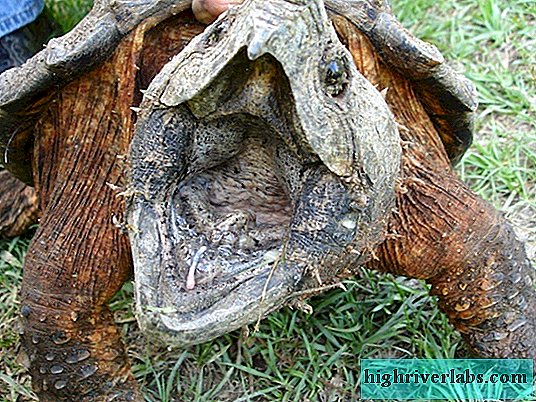Today, zoologists are aware of 230 species of turtles. Among these animals a special place is given to the vulture turtle.
Appearance
 Vulture Turtle (lat.Macrochelys temminckii)
Vulture Turtle (lat.Macrochelys temminckii)A turtle of this species can grow up to one and a half meters in length and weigh about 80 kg. On its upper jaw is the so-called beak, very similar to the beak of the neck, hence the name of this turtle. Another distinguishing feature is the presence in the tongue of a small constantly moving process, which looks like a small worm.
On a huge head are eyes that are directed sideways. On the dark green carapace there are three bony sawtooth crests above, but the soft tissues below the torso’s trunk are practically unprotected. But the tail of this turtle is not small, in size it is quite a bit inferior to the crocodile tail.
 Vulture turtle is one of the most harmless representatives of reptiles.
Vulture turtle is one of the most harmless representatives of reptiles.In general, the turtle looks repulsive, especially this sensation is reinforced by numerous warts located on the neck and chin.
Where does the vulture tortoise live?
This freshwater animal is common in the southern rivers, ponds and canals of the United States. These are mainly the Mississippi River Basins, as well as the northern part of Illinois.
Lifestyle
 A vulture turtle spends most of its life in water.
A vulture turtle spends most of its life in water.Like most turtles, she spend most of her life cycle in water.
Due to these circumstances, over the years, the shell of the vulture tortoise is overgrown with algae, thereby providing it with an excellent disguise in muddy water or in thickets.
The presence of sharp vision provides the turtle with good visibility in the underwater space, and the inhalation of a sufficient amount of air allows it to survive under water for up to 50 minutes. This freshwater is an active daytime predator. In the wild, the vulture tortoise survives to 60 years.
 Vision and hearing are perfectly adapted to the aquatic lifestyle.
Vision and hearing are perfectly adapted to the aquatic lifestyle.Vulture tortoise
The main source of food for this turtle is the fish, which it catches in a very interesting way. She digs into the silt and opens her mouth and waits for her prey. In this case, the bait is located on the tongue of a stirring process, interested in which the fish swims close to the turtle, and that in turn very quickly closes its jaws, while capturing the victim.
In addition to fish, this freshwater animal eats plants, crayfish, various worms, snails, small turtles and snakes, and also, on occasion, does not miss the opportunity to eat aquatic birds.
 The jaws of this turtle are a dangerous weapon.
The jaws of this turtle are a dangerous weapon.Breeding
The mating period for this species of turtles begins in early March, and egg laying occurs in May or June. The female hides her eggs, the number of which can vary from 20 to 40 pieces, in a pit dug up to 60 cm deep with her hind legs. Then she carefully levels the masonry surface, thereby destroying all traces that can attract nest thieves.
Having fulfilled her parental duty, she returns to the water and is no longer interested in future offspring. Small green turtles that were born have a body measuring only 5 - 6 cm. The innate instinct makes them immediately go to the water.
 With these jaws you can easily bite off your finger.
With these jaws you can easily bite off your finger.Vulture Turtle Enemies
As such, enemies in adults of these turtles were not observed in the wild.
To date, the only enemy of the vulture tortoise is man. Despite the fact that hunting for these freshwater animals is prohibited, this does not stop them from killing for the delicious taste of meat, which goes to make tortoise soup. In addition, their powerful carapace is much appreciated on the black market.
 Thanks to such "equipment", the vulture turtle has no enemies in nature.
Thanks to such "equipment", the vulture turtle has no enemies in nature.To this species was not completely destroyed, these turtles are bred in zoos. For example, in the Chicago zoo lives a vulture turtle, weighing 107 kg.
 Man is the only enemy of this reptile.
Man is the only enemy of this reptile.










